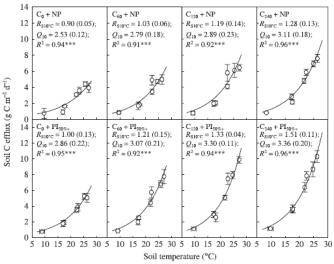Global warming is generally expected to increase production in grassland ecosystems of northern China, thus resulting in increased soil carbon (C) inputs. Understanding is limited on how increased soil C inputs would affect below-ground C cycling in ecosystems. The group led by Prof. Guangsheng Zhou conducted experiments, including the addition of particulate organic matter at rates equivalent to 0, 60, 120 and 240 g C.m ?2 in a 10-20 cm soil layer, under either natural precipitation or enhanced precipitation during the summer in a Stipa krylovii  grassland community in Duolun of Inner Mongolia, northern China. The investigators observed that the addition of soil C and enhanced precipitation had a large effect on plant biomass, soil microbial biomass and activity, and soil C efflux, and that a major part of the added soil C was rapidly lost from the system. This finding suggests that microbial activity is energy limited, and increased soil C inputs significantly affect below-ground C cycling in a Stipa krylovii grassland community of northern China ( New Phytologist, 2007).
grassland community in Duolun of Inner Mongolia, northern China. The investigators observed that the addition of soil C and enhanced precipitation had a large effect on plant biomass, soil microbial biomass and activity, and soil C efflux, and that a major part of the added soil C was rapidly lost from the system. This finding suggests that microbial activity is energy limited, and increased soil C inputs significantly affect below-ground C cycling in a Stipa krylovii grassland community of northern China ( New Phytologist, 2007).
Figure. Rates of soil carbon (C) efflux as a function of soil temperature at a depth of 10 cm under different rates of subsoil particulate organic matter (POM) addition (0 (C 0 ), 60 (C 60 ), 120 (C 120 ), and 240 (C 240 ) g C. m ?2 ) with natural precipitation (NP) or simulation of a 50% increase in summer precipitation (PI 50%+ ) in a Stipa krylovii grassland community of northern China. R 2 , multiple coefficient of determination. Significance level: *** P < 0.001. Estimates of the basal rate of soil respiration at 10 ℃ ( R S10 ℃ ) and the increase in R S for every 10 ℃ increase in temperature ( Q 10 ) with the standard error of the mean in brackets are also shown in each graph.
